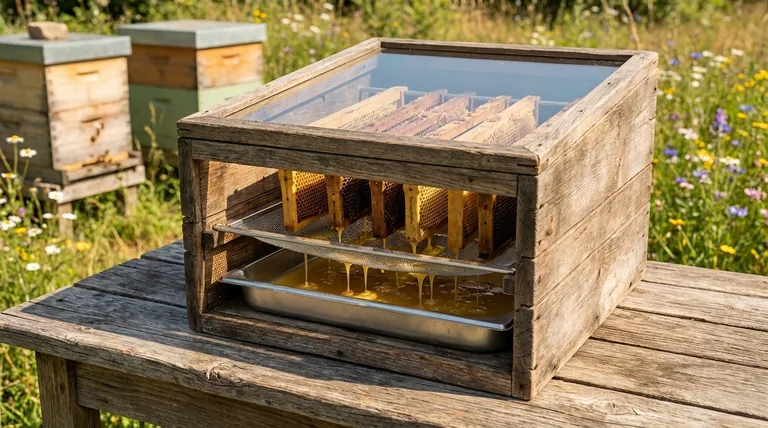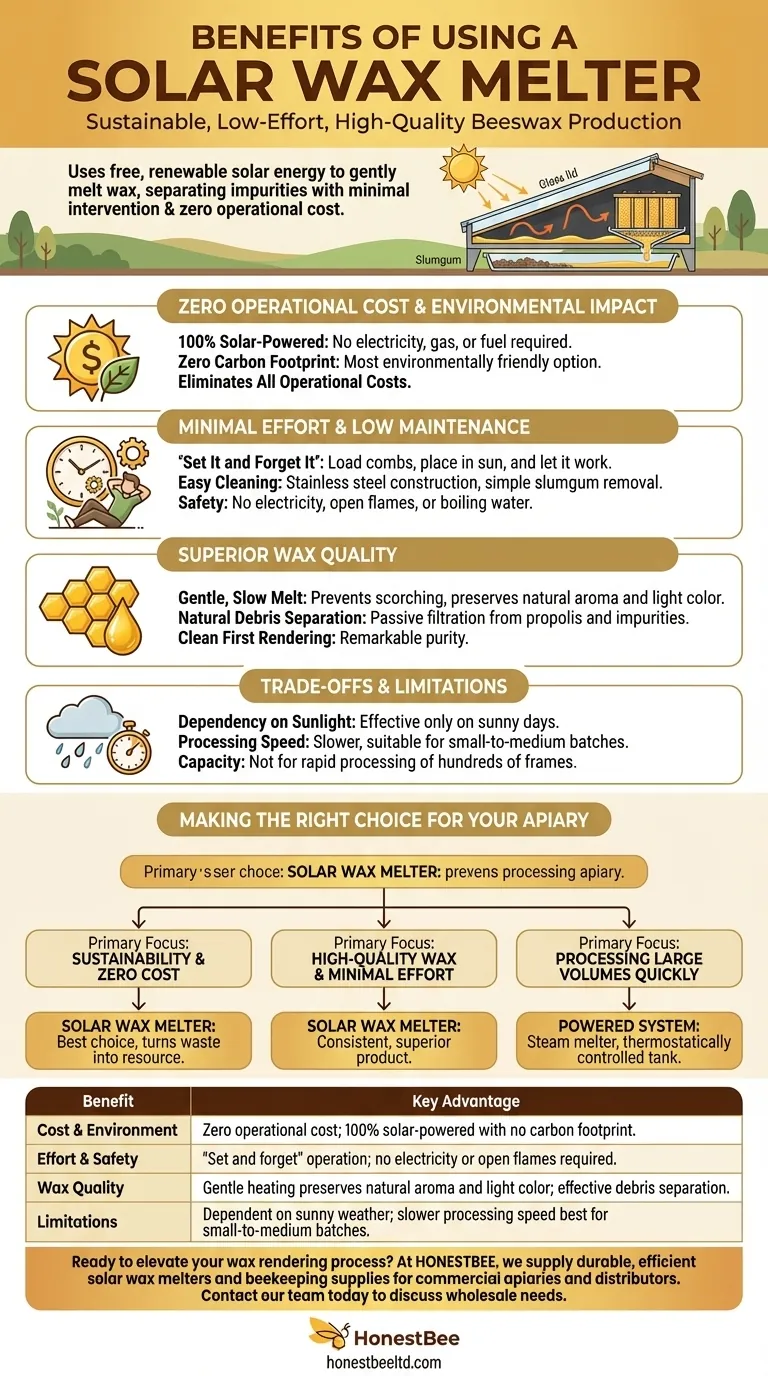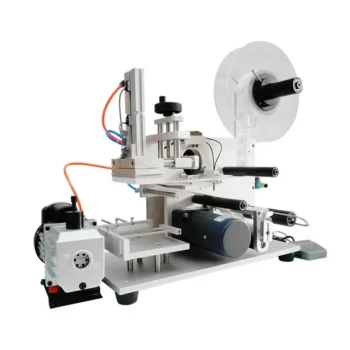In short, a solar wax melter is an exceptionally sustainable and low-effort method for producing high-quality beeswax. It uses the free, renewable energy of the sun to gently melt wax from old combs, separating it from impurities with minimal intervention and zero operational cost.
While other methods can render wax faster, the solar melter's primary advantage lies in its unique combination of simplicity, cost-effectiveness, and ability to produce a superior-quality final product with almost no hands-on effort.

How a Solar Melter Simplifies Wax Rendering
A solar wax melter is a simple yet brilliant device. It's essentially an insulated box with a dark interior and a glass lid, designed to trap solar heat like a miniature greenhouse. Old combs are placed inside, and as the sun's energy builds, the wax melts and drips through a filter into a collection pan.
Zero Operational Cost and Environmental Impact
The most significant benefit is its power source. By relying entirely on the sun, the melter requires no electricity, gas, or any other fuel.
This eliminates all operational costs associated with rendering wax. More importantly, it operates with a zero-carbon footprint, making it the most environmentally friendly option available to a beekeeper.
Minimal Effort and Low Maintenance
The process is often described as "set it and forget it." You simply load the combs into the melter in the morning, position it in a sunny spot, and let the sun do all the work.
Modern melters, often constructed from stainless steel, are also incredibly easy to clean. The leftover debris, known as slumgum, is easily scraped out once the process is complete.
Safety and Flexibility
Without the need for electricity, open flames, or boiling water, a solar wax melter is inherently safer than stovetop methods. It can be used anywhere with direct sunlight, offering flexibility for apiaries that may not have easy access to power.
The Impact on Wax Quality
The method used to render wax has a direct effect on its final quality. The slow, gentle heat of a solar melter offers distinct advantages over rapid, high-temperature methods.
A Slow Melt for Superior Wax
The slow and controlled heating process prevents the wax from being scorched or overheated. This preserves the wax's natural, pleasant aroma and its desirable light color.
Rapid heating, by contrast, can darken the wax and degrade its quality, making it less suitable for high-value products like cosmetics or candles.
Natural and Effective Debris Separation
As the wax melts, it naturally separates from heavier impurities like propolis, pollen, and larval cocoons. The pure liquid wax drips down, leaving the slumgum behind on the melting tray. This passive filtration results in a remarkably clean first rendering.
Understanding the Trade-offs and Limitations
While highly beneficial, a solar wax melter is not the perfect solution for every situation. Its effectiveness is bound by a few key constraints.
The Dependency on Sunlight
The most obvious limitation is its complete reliance on the weather. A solar melter is highly effective on long, sunny summer days but is useless on cloudy days, during winter months, or in regions with infrequent sunshine.
Processing Speed and Batch Size
This method is thorough but not fast. It is perfectly suited for hobbyist and small-scale beekeepers processing wax from a few hives.
However, for large commercial operations that need to process hundreds of frames quickly, the slower pace and limited capacity of a typical solar melter would create a significant bottleneck.
Making the Right Choice for Your Apiary
Choosing your wax rendering method depends entirely on your scale, priorities, and local climate.
- If your primary focus is sustainability and zero operational cost: A solar wax melter is the undisputed best choice, turning a waste product into a valuable resource using only free energy.
- If your primary focus is achieving high-quality wax with minimal hands-on effort: The gentle, automated nature of a solar melter will consistently produce a superior product for small-to-medium batches.
- If your primary focus is processing large volumes quickly regardless of the weather: You will need to invest in a powered system, such as a steam melter or a large, thermostatically controlled tank.
By aligning the tool with your goal, you can efficiently render your beeswax in a way that best serves your apiary's needs.
Summary Table:
| Benefit | Key Advantage |
|---|---|
| Cost & Environment | Zero operational cost; 100% solar-powered with no carbon footprint. |
| Effort & Safety | "Set and forget" operation; no electricity or open flames required. |
| Wax Quality | Gentle heating preserves natural aroma and light color; effective debris separation. |
| Limitations | Dependent on sunny weather; slower processing speed best for small-to-medium batches. |
Ready to elevate your wax rendering process with sustainable, high-quality results?
At HONESTBEE, we supply durable, efficient solar wax melters and other essential beekeeping supplies to commercial apiaries and equipment distributors. Our wholesale-focused operations ensure you get the reliable equipment you need to maximize productivity and sustainability.
Contact our team today to discuss your wholesale needs and discover how HONESTBEE can support your operation's success.
Visual Guide

Related Products
- Professional Thermostatic Conical Honey Melter
- Professional Frame Preparation: The HONESTBEE Electric Wire Embedder
- Beehive Handle and Frame Rest Cutting Machine: Your Specialized Hive Machine
- High Quality Honey Dehumidifier Dryer Thickening Machine for Beekeeping
- Honey Concentrating Vacuum Heating Thickening Machine Dehumidifier for Honey
People Also Ask
- What is melter honey used for? A Low-Cost Ingredient for Bakers and Brewers
- Is it safe to heat crystallized honey? Restore Your Honey's Liquid State Safely
- At what temperature does honey flow? Preserve Quality with the Perfect 95°F Sweet Spot
- Why is heating honey sometimes necessary? The Essential Guide to Processing & Quality
- What equipment is commonly used for heating and processing honey? Essential Tools for Every Beekeeper



















